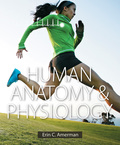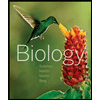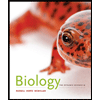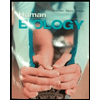
EBK HUMAN ANATOMY & PHYSIOLOGY
16th Edition
ISBN: 8220100659836
Author: AMERMAN
Publisher: PEARSON
expand_more
expand_more
format_list_bulleted
Concept explainers
Textbook Question
Chapter 2.1, Problem 4QC
What is an element?
Expert Solution & Answer
Want to see the full answer?
Check out a sample textbook solution
Students have asked these similar questions
What will control the rate of bioremediation of petroleum? (Choose all correct answers)
The availability of the petroleum
The temperature of the water
The availability of oxygen
The percent of the population that has degraded petroleum in the past
Which of the following would lead to a false negative result in a sandwich ELISA (the lab manual refers to this as a direct ELISA- also known as search for antigen)? Mark all correct answers.
antibody was non-specific and bound to something other than the antigen of interest.
too short of a duration when incubating the reagents in the plate.
If there are multiple strains of the pathogen of interest and the antibody does not recognize one of the strains.
Did not sample the correct bodily fluid/area to detect the antigen
concentration of antigen was too low to detect in the patient sample.
inadequate washing was performed after the enzyme linked antibody was allowed to bind.
substrate was exposed to too much light
reusing a pipette that was used to pipette a positive sample.
S.
+1269 pts
/1500
© Macmillan Learning
0
Resources
Solution
Penalized
Feedback
Try Again
Draw the final product with stereochemistry and lone pairs. The leaving group has been pre-drawn for
your convenience.
+100
+100
: 0:
+
H,C-
:0:
: 0
0 :
+100
+94
possible
✓ +100
K
Attemp
Chapter 2 Solutions
EBK HUMAN ANATOMY & PHYSIOLOGY
Ch. 2.1 - Prob. 1QCCh. 2.1 - What are atoms?Ch. 2.1 - How do the three types of subatomic particles...Ch. 2.1 - What is an element?Ch. 2.1 - 4. How are elements arranged in the periodic...Ch. 2.1 - What are isotopes?Ch. 2.1 - Prob. 1AWYLCh. 2.1 - The element lithium has an atomic number of 3 and...Ch. 2.2 - What is a mixture?Ch. 2.2 - 2. How do the three types of mixtures differ?
Ch. 2.2 - Prob. 3QCCh. 2.2 - What is an ionic bond?Ch. 2.2 - 5. How is an ionic bond formed?
Ch. 2.2 - 6. Explain how polar and nonpolar covalent bonds...Ch. 2.2 - What are hydrogen bonds? Why do hydrogen bonds...Ch. 2.2 - Which would be more reactive-an atom of fluorine...Ch. 2.2 - Would a molecule of hydrogen (H2) form hydrogen...Ch. 2.2 - Explain why the molecule Na2 does not exist in...Ch. 2.3 - Prob. 1QCCh. 2.3 - Prob. 2QCCh. 2.3 - How do endergonic and exergonic reactions differ?Ch. 2.3 - Prob. 4QCCh. 2.3 - What factors can influence the rate of a chemical...Ch. 2.3 - 6. What is an enzyme, and what does an enzyme do?
Ch. 2.3 - Prob. 1AWYLCh. 2.3 - Explain why most biological molecules are stable...Ch. 2.3 - 3. Many naturally occurring poisons function by...Ch. 2.4 - What are four properties of water that make it a...Ch. 2.4 - 2. Which molecules are likely to be hydrophilic?...Ch. 2.4 - 3. Define the terms acid and base.
Ch. 2.4 - What is the pH scale? Which pH values are...Ch. 2.4 - What is the effect of a buffer on a solution?Ch. 2.4 - What is a salt?Ch. 2.4 - 7. What does an electrolyte do in a solution?
Ch. 2.4 - Explain how the water surrounding a fetus in the...Ch. 2.4 - Prob. 2AWYLCh. 2.5 - 1. How do polymers and monomers differ?
Ch. 2.5 - 2.3. How do monosaccharides, disaccharides, and...Ch. 2.5 - 2. How do monosaccharides, disaccharides, and...Ch. 2.5 - How are two monosaccharides linked to form a...Ch. 2.5 - Prob. 5QCCh. 2.5 - 5. How do phospholipids and triglycerides differ?
Ch. 2.5 - What are steroids?Ch. 2.5 - Prob. 8QCCh. 2.5 - How are amino acids linked to form peptides and...Ch. 2.5 - What are the four levels of structural...Ch. 2.5 - 10. What are the components and roles of ATP?
Ch. 2.5 - 11. How do DNA and RNA differ?
Ch. 2.5 - 11. What are the three components of a...Ch. 2.5 - Which molecule would be the most soluble in water:...Ch. 2.5 - In Module 2.3, you learned that increasing...Ch. 2.5 - 3. How could a defect in a gene lead to a...Ch. 2 - Prob. 1CYRCh. 2 - Fill in the blanks: Isotopes are atoms with the...Ch. 2 - 3. Which of the following statements correctly...Ch. 2 - 4. Explain the difference between an ionic and a...Ch. 2 - Identify each of the following molecules or...Ch. 2 - What are hydrogen bonds, and how do they form?Ch. 2 - Prob. 7CYRCh. 2 - Prob. 8CYRCh. 2 - Which of the following would not result in an...Ch. 2 - 10. An enzyme is a:
a. biological catalyst that...Ch. 2 - Prob. 11CYRCh. 2 - With respect to their solubility in water,...Ch. 2 - Mark the following statements as true or false. If...Ch. 2 - A salt is: a. a metal cation bonded to a nonmetal...Ch. 2 - 15. Compare and contrast the structures of...Ch. 2 - 16. Mark the following statements as true or...Ch. 2 - 17. Why is it important for a protein to maintain...Ch. 2 - Which of the following is not part of a...Ch. 2 - 19. Mark the following properties as belonging to...Ch. 2 - Which of the following statements is/are true...Ch. 2 - 1. In certain types of radioactive decay, the...Ch. 2 - Considering that water is a main component of the...Ch. 2 - 3. Explain why monosaccharides are polar and fatty...Ch. 2 - 1. The polysaccharide cellulose is not digestible...Ch. 2 - Some claim that the pH of your blood can be...Ch. 2 - Prob. 3AYKCh. 2 - Prob. 5AYKCh. 2 - You have just dropped some phospholipids into...
Knowledge Booster
Learn more about
Need a deep-dive on the concept behind this application? Look no further. Learn more about this topic, biology and related others by exploring similar questions and additional content below.Similar questions
- +1269 pts /1500 © Macmillan Learning t/1188d950-dd73-11e0-9572-0800200c9a66/3045511b-267e-4a00-86ca-85dbc62ecb4e/6ac3a0c9-... a □ 出 All Bookmarks Due: Mon, May 26 Resources Solution Penalized Feedback Try Again KX Attempt 3 Draw the final product with stereochemistry and lone pairs. The leaving group has been pre-drawn for your convenience. :0: + нс H,C- :0: : 0:arrow_forwards. +1169 pts /1500 © Macmillan Learning 0 Resources Hint Submit Answer Step 3: This tertiary carbocation intermediate readily undergoes elimination with any weak base to form two possible products. + + H :0: H +94 possible 3a) Draw the minor organic product of elimination. Select Draw Templates More +100 +95 possible # C Major product + Minor product 3b) Draw the major organic product of elimination. Erase Select Draw Templates More C Erasearrow_forwardExplain the Science & Society on (with links and pictures): ---- Question down below Discuss the ethical, medical, and societal implications of using advanced genetic techniques?arrow_forward
- Explain the Disease Mechanism & Impact on (with links and pictures): What causes Leigh Syndrome and why it's so deadly. Which cellular functions, organelles (especially mitochondria), and macromolecules are involved.arrow_forwardExplain the Disease Mechanism & Impact on (with links and pictures): What's going wrong inside the cell and the effects on the human body. Describe metabolism with an emphasis on cellular respiration.arrow_forwardExplain the Disease Mechanism & Impact on (with links and pictures):arrow_forward
- Explain the Science & Society on (with links and pictures): Discuss the ethical, medical, and societal implications of using advanced genetic techniques.arrow_forward↑ LED Tt O Tt e 0 ✓ B > FLORES DIology Second Semester Review 7. Chi Square Analysis: wild dumpy male x ebony wild female F1: All wild wild F2: 142 wild wild males 52 wild ebony males 46 dumpy wild males 17 dumpy ebony males 151 wild wild females 47 wild ebony females 51 dumpy wild females 8 dumpy ebony females What pattern of inheritance is observed for body color? Autosomal recessive Autosomal dominant Sex-linked recessive Sex-linked dominant What are the genotypes of the parents in the P generation? a. XBYdd x XbXbDD b. Bbdd x bbDd c. BBdd x bbDD d. BBX Y x bbXDY How many flies in the F2 generation would you expect to express the dumpy wild phenotype? a. 289.125 b. 97 c. 96.375 d. 293arrow_forward4. This question focuses on entrainment. a. What is entrainment? b. What environmental cues are involved in entrainment, and which one is most influential? c. Why is entrainment necessary? d. Assuming that a flash of darkness is an effective zeitgeber, what impact on circadian rhythms would you expect to result from an event such as the 2024 solar eclipse (assume it was viewed from Carbondale IL, where totality occurred at about 2 pm)? Explain your reasoning. You may wish to consult this phase response diagram. Phase Shift (Hours) Delay Zone Advance Zone Dawn Mid-day Dusk Night Dawn Time of Light Stimulus e. Finally, give a real-world example of how knowledge of circadian rhythms and entrainment has implications for human health and wellbeing or conservation biology. This example could be from your reading or from things discussed in class.arrow_forward
- Generate one question that requires a Punnet Squre to solve the question. Then show how you calculate the possibilities of genotype and phenotypearrow_forwardBriefly state the physical meaning of the electrocapillary equation (Lippman equation).arrow_forwardExplain in a small summary how: What genetic information can be obtained from a Punnet square? What genetic information cannot be determined from a Punnet square? Why might a Punnet Square be beneficial to understanding genetics/inheritance?arrow_forward
arrow_back_ios
SEE MORE QUESTIONS
arrow_forward_ios
Recommended textbooks for you
 Principles Of Radiographic Imaging: An Art And A ...Health & NutritionISBN:9781337711067Author:Richard R. Carlton, Arlene M. Adler, Vesna BalacPublisher:Cengage Learning
Principles Of Radiographic Imaging: An Art And A ...Health & NutritionISBN:9781337711067Author:Richard R. Carlton, Arlene M. Adler, Vesna BalacPublisher:Cengage Learning Biology (MindTap Course List)BiologyISBN:9781337392938Author:Eldra Solomon, Charles Martin, Diana W. Martin, Linda R. BergPublisher:Cengage Learning
Biology (MindTap Course List)BiologyISBN:9781337392938Author:Eldra Solomon, Charles Martin, Diana W. Martin, Linda R. BergPublisher:Cengage Learning Biology: The Dynamic Science (MindTap Course List)BiologyISBN:9781305389892Author:Peter J. Russell, Paul E. Hertz, Beverly McMillanPublisher:Cengage Learning
Biology: The Dynamic Science (MindTap Course List)BiologyISBN:9781305389892Author:Peter J. Russell, Paul E. Hertz, Beverly McMillanPublisher:Cengage Learning Human Biology (MindTap Course List)BiologyISBN:9781305112100Author:Cecie Starr, Beverly McMillanPublisher:Cengage Learning
Human Biology (MindTap Course List)BiologyISBN:9781305112100Author:Cecie Starr, Beverly McMillanPublisher:Cengage Learning

Principles Of Radiographic Imaging: An Art And A ...
Health & Nutrition
ISBN:9781337711067
Author:Richard R. Carlton, Arlene M. Adler, Vesna Balac
Publisher:Cengage Learning

Biology (MindTap Course List)
Biology
ISBN:9781337392938
Author:Eldra Solomon, Charles Martin, Diana W. Martin, Linda R. Berg
Publisher:Cengage Learning


Biology: The Dynamic Science (MindTap Course List)
Biology
ISBN:9781305389892
Author:Peter J. Russell, Paul E. Hertz, Beverly McMillan
Publisher:Cengage Learning


Human Biology (MindTap Course List)
Biology
ISBN:9781305112100
Author:Cecie Starr, Beverly McMillan
Publisher:Cengage Learning
Macromolecules | Classes and Functions; Author: 2 Minute Classroom;https://www.youtube.com/watch?v=V5hhrDFo8Vk;License: Standard youtube license